Shooting options on the move
Shooting options on the move
A stable position is the basis for accurate shooting. I believe this skill is crucial to getting the shot you want and is the foundation of a successful hunt. There are many different ways to achieve a stable shooting position: depending on the environment, terrain and equipment. In this article, I would like to introduce you to the equipment and the way of using it, which I personally use when hunting on the move, especially on the stalks or a driven hunt.
Over the past few seasons, I have tried many specific pieces of equipment that promised this or that, some I have tested and returned with thanks, others I have given another chance, and eventually purchased. The equipment you will find below is all tested by me, bought with my own money and used more or less throughout the year. From chasing deer through the meadows in the spring, to the winter chase season.
Start by setting up your rifle
Shooting has its own specifics, and in many ways it comes down to whether the setup is appropriate for the activity. My 7 kg target rifle is hard to take to the stalks. However, weight, while it offers itself, is not the main limitation. The gun I'm talking about is set up for best results when shooting in the prone position, where the body position is different from shooting a gun you use sitting or standing. The fundamental difference in a gun designed for upright hunting is the length of the stock, the height of the stock, and the distance of the eye from the shooting optic. If the weapon does not collapse with you when you're shooting fast, you need to adjust the assembly. Adjust, or have the rifle adjusted, so that you are able to position and rest your head in the same spot when sighting in, not have to look for the sight picture, and are able to reduce the time it takes to sight in. Related to this is the correct cheekpiece height and eye relief from the rifle scope. This major change will translate into all shooting aspects and will greatly advance your ability to hit.
Basic shooting principles
Marksmanship is not a new field, the procedures have been tried and tested for years and many professional shooters have mastered them to near perfection. In this article, I will focus purely on equipment. I am deliberately leaving out analyzing positions, breath control, controlling your equipment, adjusting your optics, triggering, recoil absorption, ballistics, the effect of weather conditions, etc., which alone would make for a book or at least a series of technical articles. Staying with shooting in motion, i.e. in a changing environment, I follow the basic principles.
Let's start with the gun:
- A propped gun is always more accurate than a loose gun.
- Maximize the size of the area the gun is resting on.
- Never touch the barrel of the rifle - not with body parts or anything in the environment.
- Always try to put the gun onto cushioned support.
- Try to store the gun in its center of gravity.
We'll come back to these points in the examples below. But first, let's go over some basic rules for shooters:
Always try to lower the center of gravity as much as possible.
- Fill in as much space as possible between body, ground, limbs.
- Try to lighten the lowering hand as much as possible and trigger freely.
- Use your normal equipment that you have with you to better stabilize yourself.
- Always try to keep the gun supported at two points - e.g. forearm and supported elbow.
- At the range, practice as you hunt.
Shooting sticks
When I talk to fellow hunters, usually the first choice to refine shooting in motion is a shooting stick. This is especially true for hunting areas with a lack of natural obstacles - meadows, field hunting, etc. Shooting sticks, if I am talking about the number of points of contact with the gun, are of two types - single-point and double-point. Which one do I use? Both! Because each has its uses and advantages. I have a single-point tripod type of telescopic support. I use it mainly during the driven hunt season. The main advantage of this prop is that it stands on its own. So I usually set it up so that it serves as a fulcrum for shooting from the stand at longer range. For example, I'm guarding a section where I'm going to shoot handheld, and the prop serves as a fulcrum for me to shoot into a section where handheld shooting would already be a problem. If I see a piece at a longer distance, I rest the gun in the prop. Resting the gun at one point also allows for quick horizontal guidance of the gun.
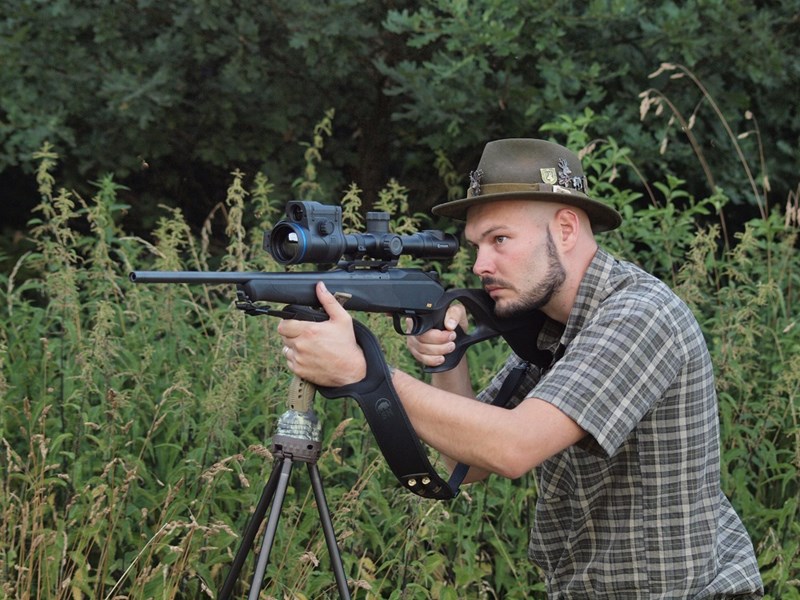
Shooting tripod – lover your body, benefit from the lowered center of gravity
I refer to basic shooting principles when using a single point rest. With a single point prop, you lighten your hands and the main weight of the gun rests on the prop. However, for the purposes of long range shooting, it is the moving second point - you - that is the limiting factor. Try to lower your center of gravity as much as possible, shoot leaning against a tree if possible, from a kneeling position using the environment or a chair as a second fixed point for your elbow.
On the other hand, a two-point rest is made for a completely solid hold on the gun. I use a two-point prop almost every time I go out. I take it not only into the field, but even when I'm moving between poses because it allows me to shoot "off hand" at really long distances. My longest shot with a two-point prop is at a distance of even 340 meters. A huge advantage of the two-point brace is stability. Body movements are not transferred to the supported gun, you make lateral and elevation correction by tilting and adjusting the front fork, and you can also support some of your own weight in the support at the same time. Using a two-point prop also makes you better able to handle recoil, so when I let prospects shoot my more powerful guns, I usually let them shoot from a two-point prop. Because of the height adjustment, you can use the two-point prop even sitting in a chair.
Using a pillow or a backpack
Another option is to use a backpack or shooting bag. The principle of using both is the same. The bag is de-facto a smaller version of the backpack. The idea is to spread the weight of the rifle over a larger area and reduce the space in which it can move freely. I use a "U" shaped bag - it can be placed on obstacles such as a branch, forearm, etc. so that the bag encircles the object and holds onto it spontaneously. Alternatively, I simply place it on its side if I am placing the gun on a fallen log or rock, for example. The big advantage of the bag is that the gun stored on the bag holds itself in the centre of gravity - i.e. my gun is in the window of the bag if I am on standby and I don't have to check it when something happens. Another specific use of the bag is the ability to store it in the fork of a single point support and get a bit of extra stability.
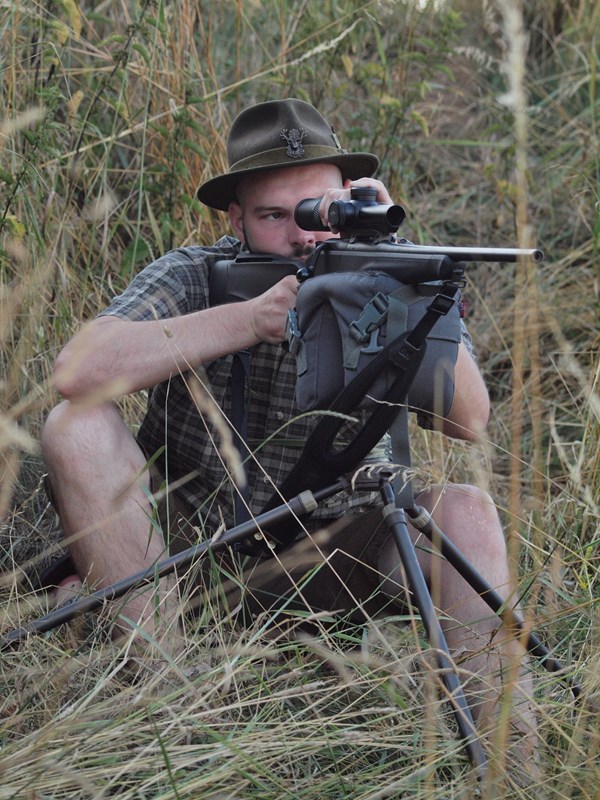
Great stable position applying multiple suggestions – use a tripod, spread the rifle weight on a pillow, rest your elbow on a knee. You can shoot really far from this one.
As I mentioned, the bag is a smaller version of a backpack. Whenever I need to support the gun, I use the pack. I often have the pack completely full, and I even carry a blanket in it, among other things, so there is no noise when I put the gun down on it. The backpack is a great substitute for shooting bipod. One advantage the backpack has over the bag, though, is that it has straps. If you throw one strap over your head and put the pack on your chest, you have a great place to rest the elbow of your hand on the trigger. Basically, this is the way that best explains the basic shooting rule of filling the maximum amount of space between your body and limbs.
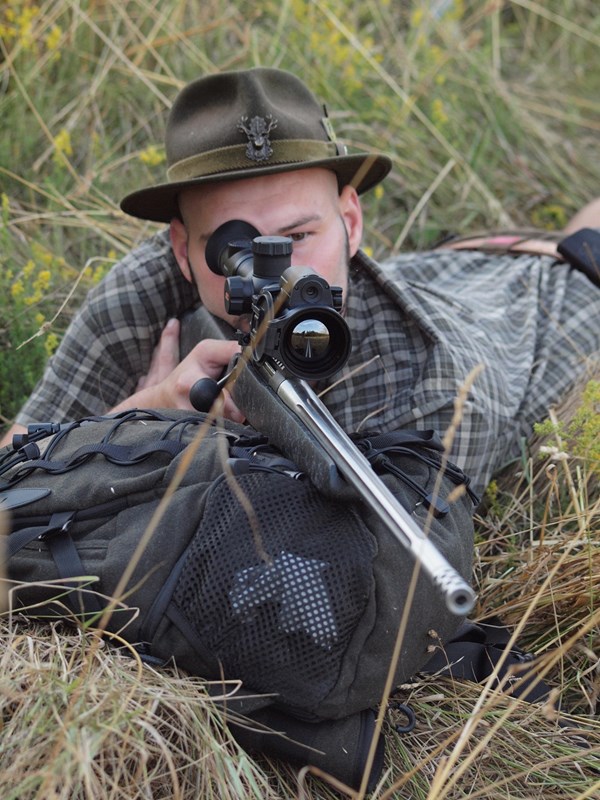
Use your backpack as a shooting pillow
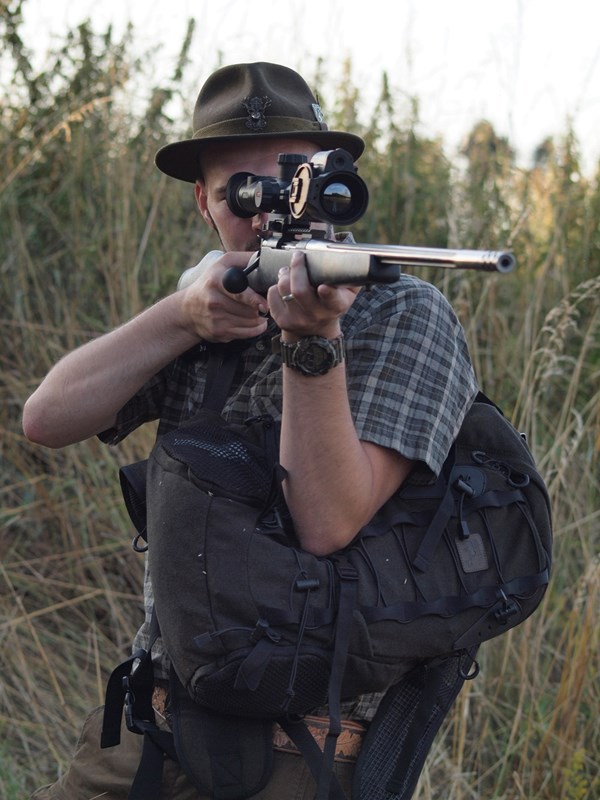
Rest your elbow on a backpack to gain more rifle support
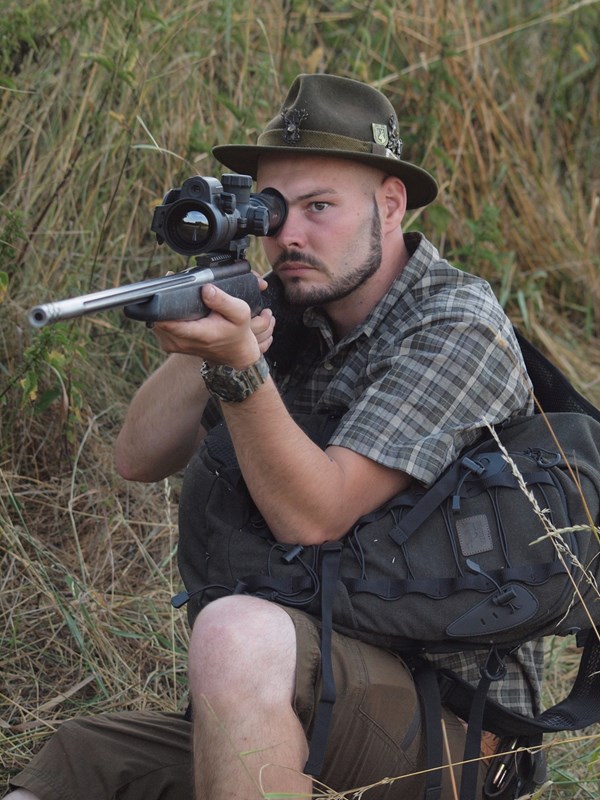
Rest your elbow on a backpack when in a knee position
Using the shooting strap
Shooting your rifle without any kind of support can be somewhat tricky. Maintaining your rifle in the correct shoulder position can be contrary to a relaxed grip and effective trigger control. To enhance your rifle's stability, improve your aim, manage recoil, and execute follow-up shots, you can employ a rifle sling. I'm talking specifically about the SH Gamehammer sling, which is specifically designed for shooting on the move. I discovered the strap at the end of last year and still shot a good portion of the driven hunt season with it. It's a modern one with a neoprene section that has an eye sewn into it, designed to push the shooter's non-shooting hand through it. By pulling with the non-shooting hand, leaning on the strap, and pulling the rifle tighter into the shoulder, the shooter will positively affect not only the position of the gun, but more importantly the control, aiming, and recoil absorbtion. The increased control allows me to shoot at longer distances directly from my hand, and if I am in an environment with natural obstacles - trees, rocks, fences, etc., I also use the sling as a substitute for a shooting stick. The key is to stabilize my own body against the obstacle, thus lowering my center of gravity and distributing my weight. I then lower the gun freely, it hangs by the belt with the support of my fixed wrist. So with just the sling, I can replace the single point support and if I use the other tips above, namely body fixation, fill in the spots, improvised support of the shooting hand, and lowering the center of gravity, I can reach out above 100 meters.
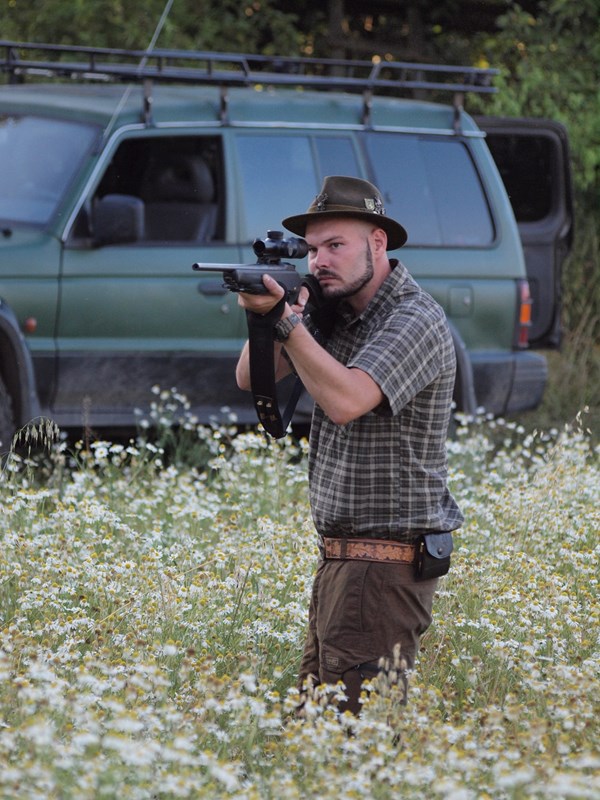
Using your sling to a better control
Conclusion
In this article I have tried to introduce you to the basic principles and equipment I use for precision shooting in my hunting practice. I will be very glad if it inspires you. If you begin to think in terms of building a shooting position in accordance with the basic rules outlined above, it will leap forward your shooting abilities. What I would like to emphasize, shooting, like many other activities, needs to be practiced. You need to have confidence in your equipment, you need to know its capabilities, and above all, try to use your time at the range to simulate the shooting positions you will subsequently encounter in practice. This will help your confidence, open up new hunting skills and limit the amount of shots that could have been worked out better.
Martin Brozek, NORMA ambassador Czech republic